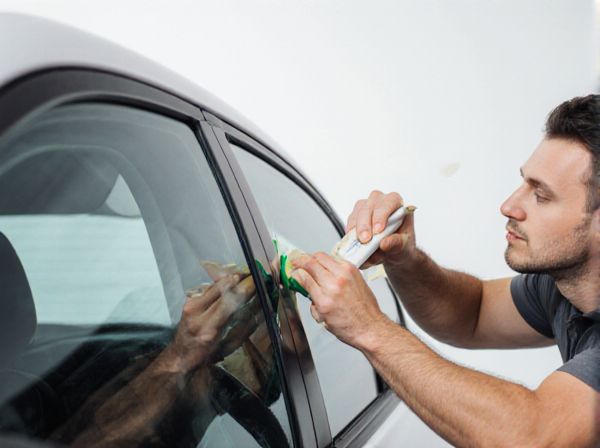
Photo illustration: Urethane Adhesive vs Butyl Tape
Urethane adhesive offers superior bonding strength and flexibility, making it ideal for automotive and construction applications that demand durability under stress. Butyl tape provides excellent waterproofing and vibration dampening but lacks the structural bond strength of urethane adhesives. You should choose urethane adhesive for applications requiring a strong, flexible seal and opt for butyl tape when moisture resistance and easy application are priorities.
Table of Comparison
| Feature | Urethane Adhesive | Butyl Tape |
|---|---|---|
| Bond Strength | High, permanent and durable | Moderate, pliable but less strong |
| Waterproofing | Excellent, fully seals against leaks | Good, effective but may degrade over time |
| Flexibility | Moderate flexibility, cures rigid | Highly flexible and pliable |
| Installation Time | Longer curing time (24 hrs+) | Quick, ready to use immediately |
| Durability | Resistant to UV, chemicals, weather | Susceptible to UV damage and aging |
| Removal | Difficult; requires solvent and tools | Easy; peels off without residue |
| Cost | Higher initial cost | Lower cost, budget-friendly |
Overview of Urethane Adhesive and Butyl Tape
Urethane adhesive is a strong, flexible bonding agent known for its excellent resistance to chemicals, weathering, and abrasion, commonly used in automotive and construction applications. Butyl tape is a sticky, rubber-like sealant valued for its waterproofing properties and ability to adhere to metal, glass, and other surfaces without shrinking or cracking. Both materials serve as effective sealing solutions, but urethane adhesive offers superior durability and elasticity, while butyl tape excels in ease of application and immediate waterproof sealing.
Chemical Composition and Properties
Urethane adhesive is a polymer-based compound primarily composed of urethane polymers, providing strong cohesive strength and excellent resistance to moisture, chemicals, and temperature variations. Butyl tape is made from synthetic rubber, specifically isobutylene-isoprene copolymer, known for its exceptional flexibility, waterproofing capabilities, and high adhesion to diverse surfaces. The urethane adhesive forms durable, rigid bonds ideal for structural applications, whereas butyl tape offers superior elasticity and sealing performance suitable for expansion joints and weatherproofing.
Application Methods and Ease of Use
Urethane adhesive requires precise surface preparation and typically involves application with a caulking gun or nozzle, providing a strong, flexible bond ideal for automotive and construction sealing. Butyl tape is pre-formed and easy to apply by hand, offering quick installation with minimal surface cleaning, making it suitable for weatherproofing and soundproofing tasks. The choice depends on project requirements, as urethane adhesive offers superior durability while butyl tape excels in convenience and speed.
Adhesion Strength and Bonding Capabilities
Urethane adhesive exhibits superior adhesion strength compared to butyl tape, providing robust and durable bonds suitable for high-stress applications such as automotive and construction industries. Its strong chemical composition allows it to bond effectively with a variety of substrates including metals, plastics, and glass, ensuring long-lasting performance under extreme weather conditions. Butyl tape, while offering excellent moisture resistance and flexibility, typically has lower adhesion strength, making it ideal for sealing rather than structural bonding.
Durability and Environmental Resistance
Urethane adhesive offers superior durability due to its strong bonding properties and resistance to UV radiation, chemicals, and extreme temperatures, making it ideal for long-term exterior applications. Butyl tape excels in elasticity and water resistance but can degrade faster under prolonged UV exposure and temperature fluctuations. For projects requiring robust environmental resistance and lasting performance, urethane adhesive is generally the preferred choice.
Common Industry Uses and Suitability
Urethane adhesive is commonly used in automotive and construction industries for bonding metals, plastics, and glass due to its strong, flexible, and weather-resistant properties. Butyl tape is primarily employed for sealing joints and seams in roofing, window installation, and HVAC applications because of its excellent moisture resistance and ease of application. Urethane adhesive offers superior structural bonding, while butyl tape is more suitable for waterproofing and sealing where flexibility and reusability are essential.
Flexibility and Movement Tolerance
Urethane adhesive offers superior flexibility, maintaining strong bonds even when subjected to dynamic stress and temperature fluctuations, making it ideal for applications with frequent movement. Butyl tape provides excellent movement tolerance with its malleable, rubber-like consistency that allows it to conform to irregular surfaces and seal gaps effectively. While urethane adhesive cures into a durable elastomer enhancing long-term elasticity, butyl tape remains pliable without curing, ensuring continuous flexibility and easy application.
Cost Comparison and Availability
Urethane adhesive typically costs more upfront than butyl tape but offers superior bonding strength and durability, which can reduce long-term maintenance expenses. Butyl tape is widely available at lower prices and is favored for quick, cost-effective sealing in construction and automotive applications. Availability of urethane adhesive may be limited to specialty suppliers, whereas butyl tape is easily sourced from major hardware stores and online retailers.
Long-Term Maintenance and Reliability
Urethane adhesive offers superior long-term durability due to its strong chemical bonding and resistance to environmental factors such as UV exposure, moisture, and temperature fluctuations, making it ideal for applications requiring consistent structural integrity. Butyl tape provides excellent initial sealing performance with flexibility and ease of application, but it can degrade over time under prolonged exposure to weather, leading to potential maintenance issues such as shrinkage or adhesive failure. For reliability in demanding conditions, urethane adhesive generally requires less frequent maintenance and ensures a longer-lasting seal compared to butyl tape.
Choosing the Right Solution for Your Project
Urethane adhesive offers superior bonding strength and flexibility, making it ideal for applications requiring long-lasting durability and resistance to environmental stress. Butyl tape provides excellent moisture sealing and ease of use, best suited for quick repairs and projects demanding airtight seals. Evaluating factors such as surface type, exposure conditions, and project duration ensures selecting the most efficient solution for optimal performance.
 caratoz.com
caratoz.com